General Motors New Vehicle Wheel Warranty Coverage

| Subject: | General Motors New Vehicle Wheel Warranty Coverage |
| Models: | 1996-2009 GM Passenger Cars and Light Duty Trucks (including Saturn) |
| 2009 and Prior HUMMER H2, H3 |
| 2005-2009 Saab 9-7X |
This bulletin is being revised to add the 2009 model year and to simplify the Warranty Information. Please discard Corporate Bulletin Number 07-03-10-015 (Section 03 -- Suspension).
The General Motors New Vehicle Wheel Warranty
This bulletin has been issued to clarify warrantable conditions on GM OEM wheels. It is our intent that this one document will answer many of the warranty scenarios you are likely to encounter. Unlike other parts of the vehicle, wheels encounter various road hazards, corrosive substances and abuses that may present questions in both the mind of the customer and the dealer. Eligible conditions are warranted for the full term of the New Vehicle Warranty.
Information Sources for Wheel Issues
The following GM Service Bulletins contain information useful to minimizing possible damage, and reducing customer concerns that may arise through incorrect servicing and improper cleaning products.
| • | #00-03-10-002D - Chemical Staining, Pitting, Corrosion and/or Spotted Appearance of Chromed Aluminum Wheels |
| • | #04-03-10-012A - Pitting and Brake Dust on Chrome Wheels |
| • | #06-03-10-004 - Proper Use of OEM Service Wheel Weights, Marring and/or Damage Due to Use of Non-OEM and/or Incorrect Wheel Weight Installation |
| • | #06-03-10-010 - Information on Proper Wheel Changing Procedures and Cautions |
What is NOT Warrantable
GM provides many different styles and finishes for our passenger car and truck wheels. You will find both steel and aluminum wheels with painted, polished or chrome finishes available. While each of these types must meet GM durability standards for road impacts and finish appearance, there are conditions that are not warrantable.
Curb Impact / Scrapes
Wheels that have been damaged through abuse are not warrantable. Finish scraping and wheel flanges that have been damaged due to curb impact are not warrantable.
Bent Wheel Flanges / Cracked Wheels
Bent wheels and cracked wheels due to road hazards are not warrantable. In many cases bent and cracked wheels result from driving on low tire air pressure or a flat tire. Low tire pressures dramatically reduce the impact protection the wheel has and lowers the threshold where damage may occur.
Finish Damage / Streaking / Pitting / Corrosion
There are many different types of finish damage possible, resulting from aggressive cleaning products, road chemicals, poor tire changing practices, or manufacturing processes. Some of these are warrantable while others indicate abuse. See the Finish Damage sections below, which give examples of the different types of specific finish concern issues you may encounter.
NON-Warrantable Examples
The following are examples of actual wheels that were returned to General Motors under the New Vehicle Warranty and have been analyzed and reviewed.
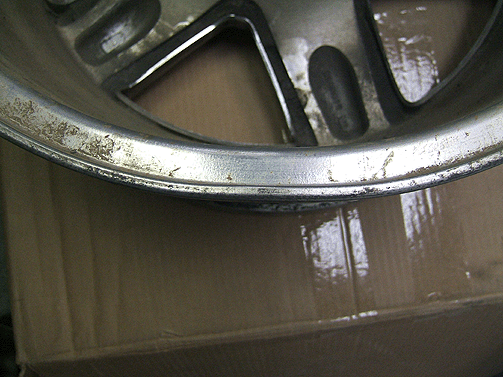
The wheel above exhibits typical wheel rim damage on the inboard flange, caused by a road hazard. Customer comments may be vibration, air loss, or a wheel that cannot be balanced. This damage is not warrantable and a Warranty Parts Center (WPC) Regional Feedback Report was issued on this wheel. (Most WPC Regional Feedback Reports result in a chargeback of the warranty claim to the dealership.)
Important: Customers whose vehicles have sustained road hazard damage due to poor road surfaces on county or state roads may have recourse through their insurance company or through the county or state road commission. These policies vary by area. Contact your country or state government to check eligibility.
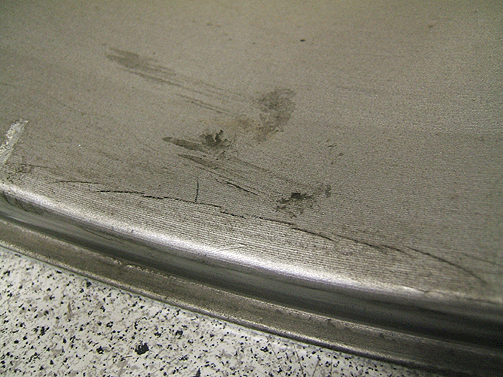
The photo above illustrates a crack in the wheel from a road hazard. In addition to the damage seen in the photo, the flange of the wheel was bent in the same area. Customer comments may include, vibration, air loss, or a wheel that cannot be balanced. This is not a warrantable condition and does not indicate any defect in the wheel. A Feedback Report was issued on this wheel.
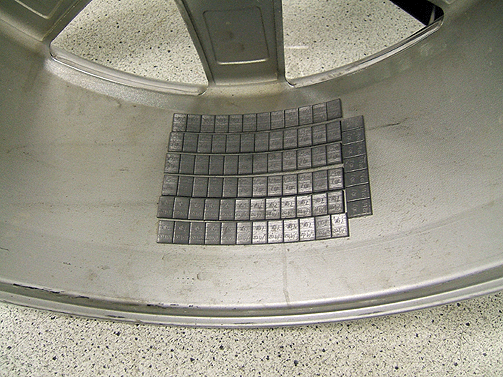
The photo above is an example of the over-use of wheel weights to try to overcome another issue. This wheel has a bent outboard flange exactly 180° from the application of 79 1/4oz. (7 gr.) wheel weights! This condition is both not-warrantable and an example of incorrect servicing. If a wheel and tire assembly will not balance, the wheel should be examined and checked for runout. The associated tire should also be checked for radial force variation.
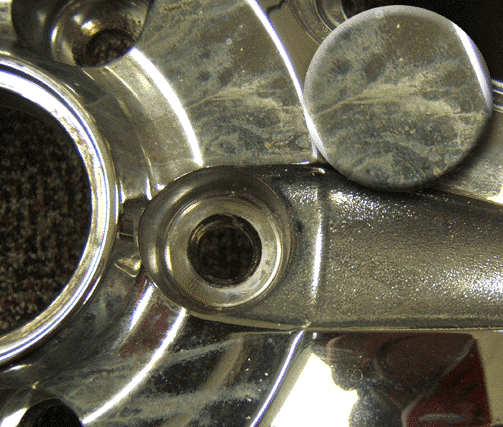
This final example above is a chemical stain that can appear on chrome wheels. This is the result of using corrosive or acidic wheel cleaners. This type of stain appears most often when non-approved cleaners are used repeatedly, allowed to remain on the surface of the wheel, or not rinsed away thoroughly. This type of damage is not warrantable.
Important:: In some cases when this type of stain is not too severe, it may be possible to improve the appearance with certain chrome cleaner/polishes. Refer to GM Service Bulletin #00-03-10-002D for additional information.
Warrantable Issues
Any defects in the finish, balance, or structure of the wheel resulting from improper manufacture are covered under the New Vehicle Warranty for the full time and mileage limits of that warranty. Typical covered finish issues that you may encounter are:
| • | Flaky or pitted chrome on the visible wheel surface indicating poor adhesion of the plating. |
| • | Polished or machined aluminum wheels that exhibit Filiform Corrosion (chalky white lines under the clear coating) This condition is warrantable, unless it is caused by incorrect wheel weight application and use. |
| • | Wheel center caps that exhibit similar conditions to warrantable wheel concerns. |
| • | Thin or poor paint finish quality on painted wheels. Bubbling / Flaking of the paint. |
| • | Paint damage incurred during stick-on wheel weight changes. (See Stick-On Wheel Weight Paint Damage or Paint Flaking/Peeling Backside of Wheel) |
| • | Flaking or peeling on backside surface of wheel indicating poor adhesion of the plating (See Stick-On Wheel Weight Paint Damage or Paint Flaking/Peeling Backside of Wheel). |
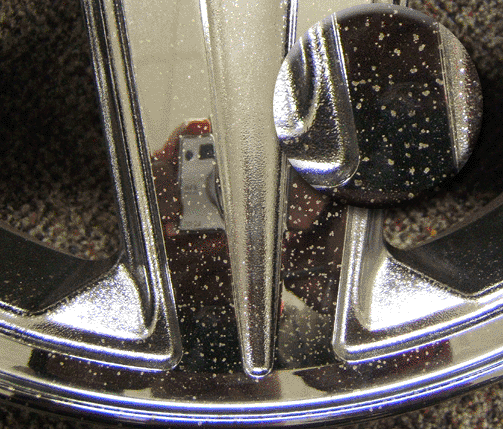
One type of finish concern specific to chromed aluminum wheels is spotting or what appears as golden colored pits on the surface (See example above). This type of finish concern is not the fault of any manufacturing or durability shortfall. This dissatisfier results from corrosive road chemicals used for dust control in some areas. (Calcium Chloride) Wheels with this type of corrosion may be eligible to be warranted one time only. Please refer to GM Service Bulletin #00-03-10-002D for additional information.
Preparing Wheel(s) for Warranty Return
The wheels returned to General Motors for warranty coverage are evaluated by a team made up of representatives from Engineering, GM Service, Quality, and the manufacturing OE Wheel Suppliers. During review of returned wheels, a finite amount of time is available to evaluate each wheel. It may benefit your dealership to observe the following guidelines for returning wheels.
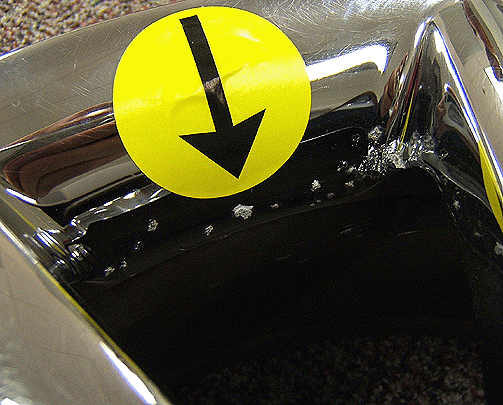
| • | Please mark the defect in the wheel. You may use a paint pen, grease marker or tape off the area. Many times the Repair Order is not clear as to the reported concern. Simply circling the area of concern on the wheel is sufficient. |
| • | Clean the wheel if it is overly dirty. It is not required that the wheel be polished or detailed. Returned wheels covered over with dirt/mud create the possibility of overlooking a cosmetic flaw that was the subject of the wheel return, creating a possible Feedback Report. |
| • | Treat the wheel with care before packing for return. Dismounted wheel rims can be scratched and bent easily if abused before packing. This type of damage can mimic road/curb damage creating a possible Feedback Report. |
Removal of Stick-On Adhesive Backed Wheel Weights
Many "flangeless" design wheels require the use of stick-on or adhesive backed wheel weights. Improper removal of the wheel weights (on chrome plated wheels) may peel, scratch or flake the paint on the interior surface of the wheel. Normally this is of no concern, but on some vehicles with wheels that are of a very open design, the interior of the wheel may be a visible surface. Here are tips to aid the removal of these weights.
| • | Use ONLY Plastic tools for removal of the wheel weights. The best tools to use are commercially available plastic putty knives or a plastic accusative trim removal tool. Use the tapered end of the tool to remove the wheel weight. These plastic tools are delicate on the painted surfaces serving to "push" the adhesive off the surface rather than scraping. |
| • | Any adhesive left on the wheel may be cleaned with an automotive adhesive remover such as 3M General Purpose Adhesive Remover #08984 or equivalent. |
| • | In most cases you will not encounter any difficulty with OEM painted aluminum wheels. Fully painted wheels have a robust paint application process that cannot be matched and duplicated. Chromed aluminum wheels have an air dry paint applied to the back side of the wheel, which is applied over a chromed surface. If a chromed aluminum wheel paint on the interior of the wheel peels, refer to the section below. |
Stick-On Wheel Weight Paint Damage or Paint Flaking/Peeling Backside of Wheel (Chromed Aluminum Wheels)
Under no circumstances should the wheel be replaced for this type of damage. Damage caused by improper removal, metal tool scrapes and gouges should not be submitted. If you encounter a wheel where the paint has peeled, you may repaint the backside of the wheel.
GM currently uses two all-purpose colors to paint the inside of the wheel area. Both colors are a flat paint available in a very light silver or dark silver. Follow all manufacturers instructions when refinishing and refer to the GM Labor Time Guide for Material Allowances noting the warranty information below.
Description | Paint Code |
|---|---|
Light Silver Metallic | WA-303L |
Dark Silver Metallic | WAEQ715Q |
Warranty Information (excluding Saab U.S. Models)
Important: GM of Canada dealers/retailers: All wheels replaced under warranty must be held for the inspection and/or scrapping by a General Motors representative, except when requested for return to the WPC.
Use the following Labor Operation when repairing a vehicle under warranty.
You are allowed to claim ONE-HALF the total amount of allowable time and materials as only the back side of the wheel is being repainted in this operation.
Labor Operation | Description | Labor Time |
|---|---|---|
A3330 | Wheels, Aluminum - Color/Clear Coat - One | Use Published Labor Operation Time |
Warranty Information (Saab U.S. Models)
Choose the appropriate labor operation based on repair:
Labor Operation | Description | Object Code | Reason Code | Location Code | Warranty Type | Repair/Action Code | Labor Time |
|---|---|---|---|---|---|---|---|
7711004 | Wheels, Aluminum - Color/Clear Coat - One Includes: R&R wheel | 7711004 | 86 | 3-left or 4-right or 5-all (if more than one wheel) | 01 | 04 | 1.2 hrs |
Add 7711005 | To Color Coat-each additional wheel includes: R&R wheel (s) | -- | -- | -- | -- | -- | 0.8 hr |
Add 1270101 | Adj. Wheel Balancing Quantity 1 | -- | -- | -- | -- | -- | Use Published Labor Operation Time |
Add 1270102 | Adj. Wheel Balancing Quantity 2 | -- | -- | -- | -- | -- | Use Published Labor Operation Time |
Add 1270103 | Adj. Wheel Balancing Quantity 4 | -- | -- | -- | -- | -- | Use Published Labor Operation Time |
